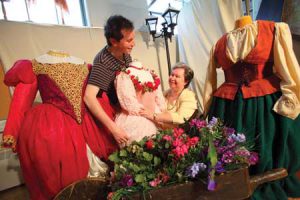
By Tamarah Feder
Dramatis Personae
Sam Neuberg, a fresh-faced, indefatigable and wickedly bright student entering his third year of Art History and English, with a concentration in Drama and Theatre.
Catherine Bradley, Head of Wardrobe for the McGill Drama and Theatre Program, whose passion for her craft is matched only by her dedication to her students. She has worked the Stratford and Shaw theatre festivals, the Banff School of Fine Arts, National Ballet, L’Opéra de Montréal, Centaur Theatre, Saidye Bronfman Centre and the National Theatre School.
Chorus, costumed spirits from the last 25 years of plays put on at Moyse Hall
Narrator
Setting
Brightly lit costume shop in basement annex of the venerable Moyse Hall, McGill University.
Fanciful vignettes with mannequins in costumes designed and sewn by McGill students from 25 years of theatrical productions from The Tempest (’93), The Servant of Two Masters (’95), Tartuffe (’93), The Importance of Being Ernest (’08), and The Alchemist (’11).
Act I
Scene opens on the basement workshop. Natural light floods in from the windows and bounces off the elaborately decorated costumes. Bradley and Neuberg scurry to put finishing touches on this first retrospective exhibit of costumes.
Sam: My hope is to work as a historical costume curator – or frankly anything to do with costume. The idea for this exhibit came out of a project for a History of Costume course I did. Catherine encouraged me to bring it to life as an Independent Study project.
Sam looks over the 900-square foot space of organized creative mayhem. Costumes, puppets, crowns, shoes and bolts of fabric await his final blocking.
Sam: I went through thousands of costumes. Some in storage, some on old slides, looking for the most eye-catching, stellar pieces that would speak to people.
Sam walks the room and tugs gently at different costumes, drawing attention to the construction and thoughtful details. He lifts the skirt of a whimsical fairy costume from this year’s production of The Alchemist designed by Claire Stewart. Then he picks up a beautiful blue and white toile de Jouy corset and turns it over to reveal the underside that few ever think to look at. He runs his fingers over the stitching, and though he’s looked at these costumes many times before, it is clear he is in awe of the exceptional quality of work by his student colleagues.

Sam (lights up): Look at the detail! This boning and pattern work! The delicate hand work! These steel-boned bodices and corsetry determine how physical the actors can get, so we have to work closely with the actors. For example, this Jacobean corset is easier for actors to move in, whereas a Victorian corset, which is longer, can be more challenging.
His mentor, Catherine Bradley, who’s been admiring her student’s enthusiasm from the side, comes over. She’s been with the workshop since 1988 and oversaw its move from a tiny room in the basement of the Morrice Hall building that houses Islamic Studies to the surprising airiness of the basement of the Moyse annex. It is a space she helped design by leading a student and faculty effort that raised thousands of dollars, inspiring the University to direct a generous donation from the coincidentally named alumna Billie Wilder (BA’51).
Catherine: The costume shop would not have happened without our donor’s help. Her donation helped finish the shop designed by McGill architect Radu Juster. We took it from a cement parking lot-type space and created a workable environment that does quadruple duty as a classroom, workshop, and storage space, and now gallery.
Narrator: Catherine’s respect for and belief in her students led to a dramatic shift in the standard costuming process. Where other theatre programs typically assign one designer for each production and then use students to sew the costumes, Bradley acted on her students’ proposal for each student to be responsible for a costume, from design to final stitch.
Catherine: My students encouraged me to try it. At first, I thought designing as a team might be unworkable, but they were so committed, and it’s worked out really well.

Narrator: The costume class works together to illuminate the play, like creating pictures for a story book. Every piece is the product of a months-long process in which everyone contributes to developing the aesthetic.
Catherine: We do intensive research for the design, looking at period portraits, history and politics to develop an overarching design concept. We create a unified colour palette, and work with the set and lighting design. Then we do a round-table with the director who reviews and chooses the sketches. Although each piece is unique and done by a different student, they are all part of a united aesthetic.
Catherine (pointing to the cartwheel ruff (as in ruffle) of the surly Spaniard character from this year’s production of The Alchemist): “There is a line in the play about how his head is on a platter, so this ruff hinted to the audience that when they saw his head it appears as though it was on a plate.”
Narrator: Bradley works on an extremely tight budget. In fact, she outfitted the entire cast of The Alchemist (that’s 17 people) head to toe, for less than the cost of a man’s suit in a medium-end shop. And that includes the all important post-production dry-cleaning.
Many of Bradley’s students have gone on to careers in costume design for opera, dance and theatre, including Linda Cho whose costumes from the 1995 production of Goldoni’s The Servant of Two Masters will be on display. After leaving McGill, Cho went on to be a guest instructor at Yale School of Drama. The award-wining costume designer has been working steadily in NYC and LA and is getting ready to see her costume designs onstage for Titus Andronicus at this summer’s Stratford Festival.
Jez Yung, another former student, is now the wardrobe manager at Montreal’s Segal Centre, and Charlotte Robertson is Costume Designer for the Sudbury Theatre Centre and has worked with the Cirque du Soleil.

A champion of her students, Catherine expresses pride in those who have gone on to find success in design, but she is equally proud of those who had no theatrical career aspirations but who wanted to become members of a motley crew of students who discover a mutual language, envision an idea, and work together to create something magical. Her students reflect the diversity of the university itself, with many coming from decidedly un-theatrical backgrounds, including applied mathematics, dentistry, and law. Catherine has been struck by how many non-“artsy-theatre-type” students apply and their emotional pleas to be admitted into a class that allows them to create.
Catherine: McGill can be perceived as very academic but this exhibition is an opportunity to showcase the creative side of our community – as actors, designers, set builders, costumers. It’s a chance to see the creative side of McGill.
Narrator: As the only professional in the costume section, Bradley teaches, cut fabrics and takes on multiple roles as do the only two other professionals in the program, the technical director and the production manager.
What more does the teacher who gives her all to her students wish for? Not another cutting table, not even another sewing machine.

Catherine (pauses thoughtfully): People tend to think about raising funds for more machinery or buildings; “cold” things. We need to change how we look at what students need. Rather than one more computer, our students can gain so much more from mentors. We need money for more paid professionals like fabric dyers, vocal coaches, choreographers, and theatre and technical administrators; people the students can learn from by working with.
Sam (who has been listening intently while adjusting the costumed mannequins, jumps in): What Catherine has taught me and done for me … I could not get that from a book or machine. There are many kinds of research and technical experiences – and this program has been serving so many of McGill’s students so well and in so many different ways – and it could do even more.
Epilogue
The exhibit runs as part of Convocation, May 30 to June 2, 1 – 3 p.m.
For more info about the exhibit go to: www.mcgill.ca/channels/events/item/?item_id=174221
